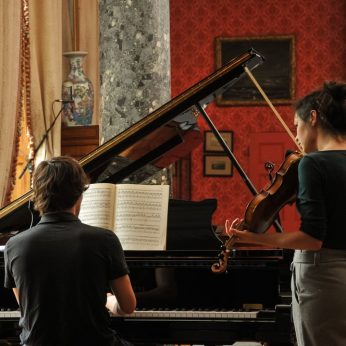Composer: Gabriel Fauré (b. 1845 - d. 1924)
Performance date: 29/06/2023
Venue: Bantry House
Composition Year: 1876
Duration: 00:28:37
Recording Engineer: Tom Norton, RTÉ
Instrumentation: vn, pf
Instrumentation Category:Duo
Artists:
Mairead Hickey -
[violin]
Jérémie Moreau -
[piano]

Violin Sonata No.1 in A major Op.13 [1876]
1. Allegro molto
2. Andante
3. Allegro vivo
4. Allegro quasi presto
In 1872 Saint-Saëns introduced Fauré to the household of the celebrated mezzo Pauline Viardot, whose Paris salon was frequented by the most important literary and musical figures of the time. Viardot was much taken with the intense young musician – He’s an excellent composer and what’s more he has a good sense of humour and he’s mad about dancing. The great singer entranced all around her, so much so that the Russian novelist, Ivan Turgenev, had followed her to Europe to become part of a highly unusual household. Viardot had three daughters and the youngest, Marianne, was a slender, pale young woman with a good singing voice with whom Fauré fell madly in love – just how madly can be heard in this passionate Sonata.
The emotional world of this Sonata is positively explosive. Unlike his cool and balanced early songs and piano works, it is filled with a passionate elation that is clearly written to sweep a particular listener off her feet. It is perhaps not surprising that Marianne’s father found the work to be involved and meaningless. The mother would have preferred that the composer had written an opera. And, to its eternal shame but eventual profit, the prestigious Leipzig music publisher, Breitkopf and Härtel, wrote: The Sonata in question is undoubtedly a remarkable piece of work and we like it very much, but M.Fauré’s name is not known in Germany and the musical market is saturated with works of this kind, though in many cases inferior to this one. We should have great difficulty in recovering our costs were we to give the composer a royalty worthy of his work, or, to put it bluntly, we cannot publish this Sonata unless M.Fauré renounces a royalty. M.Fauré did indeed renounce his royalty and it was published in 1877.
The four movements follow the outline of traditional sonata form but the composer’s favourite harmonic twists and ambiguities, extended chromatic progressions, and the malleability of his melodic phrase lengths can even now give the impression of a torrent of overwhelming intensity. Pauline Viardot was perhaps not so far off the mark in pushing Fauré towards opera for this Sonata often takes on the mantle of a passionate operatic duet and one thinks of Saint-Saëns’ description of Viardot’s marvellous voice, with its tremendous power and prodigious range, it was not a velvet or a crystal voice, but a harsh one, made for tragedy, epic verse and was more superhuman than human. Fauré was perhaps attempting to emulate Viardot’s intensity of expression in this electrifying work. Passion and beauty at this level inevitably contain the seed of tragedy and indeed the unfortunate Marianne was so overwhelmed by Fauré that she eventually rejected him, but for this evening the lovers remain united.
Francis Humphrys
Copyright © 2025 West Cork Music. All rights reserved.
Designed and developed by Matrix Internet